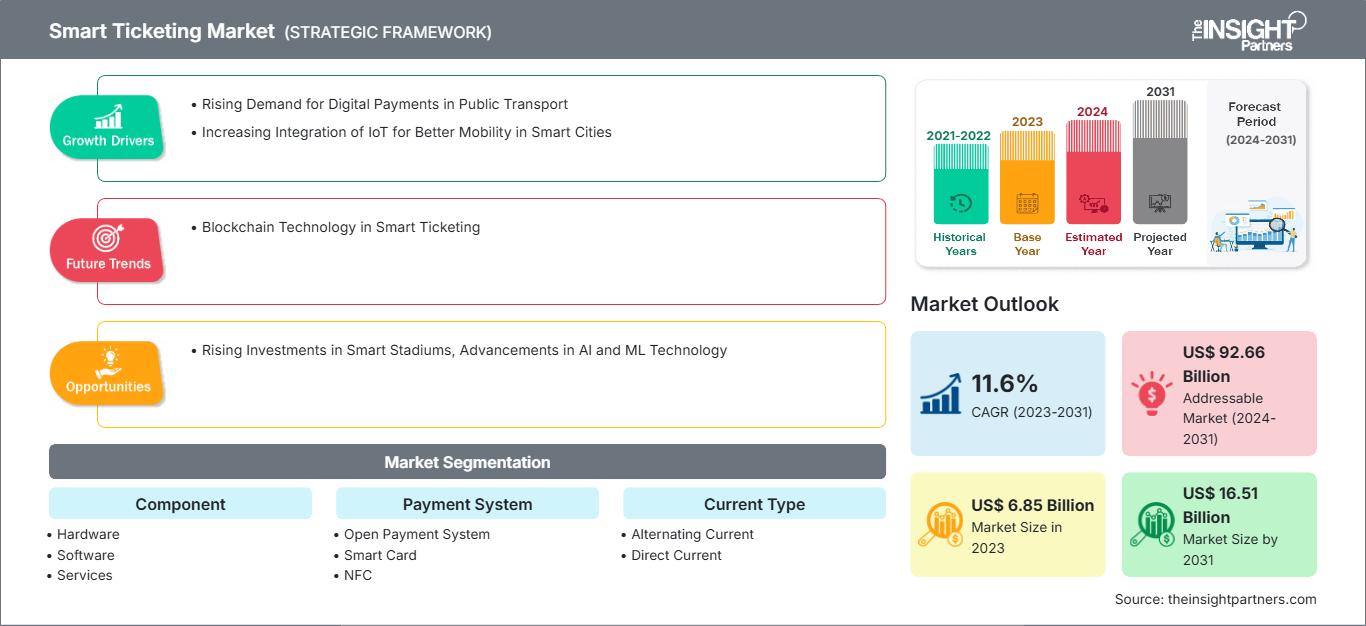スマートチケット市場規模は、2023年の68億5,000万米ドルから2031年には165億1,000万米ドルに達すると予測されています。市場は2023年から2031年にかけて年平均成長率(CAGR)11.6%を記録すると予想されています。スマートチケットにおけるブロックチェーン技術は、市場に新たなトレンドをもたらす可能性があります。
スマートチケット市場分析
スマートチケット市場は近年、著しい成長を遂げています。業界全体における急速なデジタル化などの要因により、非接触型決済への依存度が高まっています。さらに、世界中でチケット予約にスマートデバイスが普及していることも、スマートチケット市場規模の拡大に寄与すると予想されます。さらに、人工知能、仮想現実マップ、スマートフォン、ウェアラブルなどの先進技術を発券システムに統合することで、今後数年間でスマート発券市場に新たなトレンドが生まれると予想されています。
スマート発券市場の概要
旅行チケットをマイクロチップ(通常はスマートカードに搭載)に電子的に保存するプロセスは、スマート発券と呼ばれています。ITSOスマートカードを使用することで、現金や紙のチケットを受け取る従来の支払い方法が不要になり、公共交通機関の利用者はバス、路面電車、電車に簡単に乗降できるようになります。乗車を承認するために、交通機関の運営者は、静的な発券機または手持ち式の発券機を使用して、非接触型スマートカードをゲートでスキャンします。スマートチケットは、発券プロセスのデジタル化への関心の高まりを背景に、従来の紙ベースの発券に代わる現代的な手段として大きな注目を集めています。この革新的な技術は、チケット購入のために列に並ぶ必要がなくなるため、乗客の時間を節約します。また、スマートカードやモバイルアプリも活用できるようになり、紙のチケットに代わる優れた選択肢を提供しています。さらに、スマートチケットは様々な交通手段で広く利用されており、スポーツやエンターテイメントイベントでの活用も拡大しています。注目すべき例として、オリンピックを開催し、50万人の海外からの来場者を見込んでいたリオデジャネイロが挙げられます。リオデジャネイロの公共交通機関のチケットシステムには、ジェムアルトの非接触技術が採用されており、防水仕様の「Celegoコンタクトレスリストバンド」と「Celegoコンタクトレスステッカー」はどちらもジェムアルトの非接触チップを搭載し、VisaとMasterCardの認証を受けています。リストバンドを非接触リーダーにかざすだけで起動するこれらのソリューションは、世界規模で導入された重要なインフラ強化となりました。
要件に合わせてレポートをカスタマイズ
レポートの一部、国レベルの分析、Excelデータパックなどを含め、スタートアップ&大学向けに特別オファーや割引もご利用いただけます(無償)
スマートチケット市場: 戦略的洞察

-
このレポートの主要な市場動向を入手してください。この無料サンプルには、市場動向から見積もりや予測に至るまでのデータ分析が含まれます。
スマートチケット市場の推進要因と機会
公共交通機関におけるデジタル決済の需要の高まり
現代の都市では、バス、電車、地下鉄など、多様な交通手段が提供されています。各公共交通機関には独自のチケットシステムがあります。複数のスマートカードや異なる交通手段のアプリケーションを管理することは、通勤者にとって負担になる可能性があります。すべての交通ネットワークを統合するには、一元化された方法が必要です。この方向で、世界中の公共交通インフラのアップグレードが進められています。これらのアップグレードは、シームレスな決済インターフェースを通じて通勤者の体験を向上させることも目指しています。例えば、2023年5月、スマートモビリティ技術ソリューションのグローバルプロバイダーであり、Conduent Incorporated(Nasdaq: CNDT)の事業部門であるConduent Transportationは、ConduentとConvergintのパートナーシップである子会社が、オーストラリアのビクトリア州から、mykiとして知られる州の次世代公共交通チケットシステムを提供するために選定されたことを発表しました。両社は、州の既存のスマートカードソリューションをアップグレードし、利用者に優れたユーザーエクスペリエンスを提供する、高度な非接触決済アカウントベースの交通チケットシステムの導入を目指しています。2022年12月には、日立レールの旅行プラットフォーム「360Pass」がイタリアのトレンティーノで稼働を開始し、利用者は従来の切符を購入することなく、市内のあらゆる公共交通機関を利用できるようになりました。このアプリは、どのアプリストアからでも無料でアクセスできます。市民や観光客は、アプリをダウンロードすることで、スマートフォンを使って簡単にマルチモーダルチケットを購入できます。都市がスマートでコネクテッドなデジタルファースト環境へと進化するにつれ、公共交通機関のデジタル決済は引き続き最重要課題であり、スマートチケット市場の成長を牽引するでしょう。
スマートスタジアムへの投資増加
近年、非接触体験システムへの世界的なニーズが高まり、スタジアムやイベントの販売プロセスにおけるスマートチケットの活用が加速しています。スマートチケットは、スタジアムやイベント主催者が間接費や手続き上のボトルネックを回避し、業務をより効率的に運営するための簡単な方法を提供します。これは非常に重要です。なぜなら、従来の紙ベースのチケット発行では労力とリソースが多く必要となり、スポーツイベントの開催方法としては持続不可能だからです。スマートチケット発行システムを導入すれば、ファンが自分の好きな席の空席状況を確認し、好みに合ったチケットを注文できるようになり、チケットの売上を飛躍的に向上させることができます。こうした予約から得られる重要なデータにより、主催者はファンが最も興味を持っているエリアを判断でき、特定の観客層にアピールするターゲットを絞ったチケット販売戦略を立てることができます。スマートチケット発行によってチケットの検証が行われるため、スタジアムのスタッフはファン体験の向上、群衆管理の支援、情報や案内の提供、あるいは人の介入が必要な主要エリアのサポートなどに再配置できます。スマートチケット発行は、チケット発行業務を合理化することで労働者を最大限に活用し、業務効率と観客のスタジアム体験全体の向上を実現します。例えば、RFIDチケットは、2013年のFIFAコンフェデレーションズカップ、2014年のFIFAワールドカップ、2017年のFIFAコンフェデレーションズカップ、2018年のFIFAワールドカップ、2021年のFIFAアラブカップ、そしてカタールで開催されたFIFAワールドカップ2022で、何百万人ものサポーターによって利用されました。FIFAはHIDを公式チケット制作会社に任命しました。そのため、ユーザーの決済体験をシームレスにするためのスマートスタジアムへの投資の増加は、スマートチケット市場の拡大にとって有利な機会を生み出すと予想されています。
スマートチケット市場レポートのセグメンテーション分析
スマートチケット市場分析の導出に貢献した主要なセグメントは、コンポーネント、決済システム、およびエンドユーザーです。
- コンポーネントに基づいて、市場はハードウェア、ソフトウェア、およびサービスに分割されています。 2023年には、ハードウェアセグメントが最大の市場シェアを占めました。
- 決済システム別に見ると、市場はオープン決済システム、スマートカード、NFCに分かれています。2023年には、スマートカードセグメントが最大の市場シェアを占めました。
- エンドユーザー別に見ると、市場は交通、スポーツ・エンターテイメント、駐車場などに分類されています。2023年には、スポーツ・エンターテイメントセグメントが市場を席巻しました。
スマートチケット市場シェアの地域別分析
スマートチケット市場レポートの地理的範囲は、主に北米、アジア太平洋、ヨーロッパ、中東・アフリカ、南米・中米の5つの地域に分かれています。
2023年には、北米が大きな市場シェアを占めました。北米のスマートチケット市場は、スマートチケットシステムで利用されるスマートカード技術の進歩により、大幅な成長を遂げています。スマートフォンや最先端のウェアラブルデバイスを活用した非接触型ソリューションは、柔軟な決済オプションによって物理的なチケットカウンターでの時間を最適化し、煩雑さを軽減できるため、大きな注目を集めています。Samsungなどの大手スマートウェアラブルデバイスメーカーは、スマートウォッチに決済機能を導入しています。さらに、多くのデバイスメーカーは、Samsung Pay、Fitbit Pay、Apple Pay、Garmin Pay、Google Payなどの決済サービスをモバイルウォレットサービスに統合しています。スマートウォッチ対応の決済はまだ開発段階ですが、大きな市場ポテンシャルを秘めています。これらの開発により、消費者はウェアラブルデバイスを使ってチケットを購入できるようになると予測されており、チケット販売環境に大きな変化がもたらされるでしょう。さらに、Cubic Corporationなどの主要スマートチケット市場プレーヤーによる取り組みも、市場を後押ししています。
例えば、2023年5月には、InfineonがCALYPSOに参入し、オープンスタンダードに準拠した相互運用可能なチケット販売ソリューションの開発が促進されました。これにより、メーカーは交通事業者や当局の独自のニーズに合わせてソリューションをカスタマイズできるようになりました。このアプローチにより、磁気ストライプ、バーコード、独自のチケットへの依存がなくなり、多様なシステム間での柔軟性と互換性が向上します。この開発は、州全体の非接触型発券システムの近代化と拡大に向けた大きな一歩であり、今後は旅客鉄道システム全体に完全導入し、バスとフェリーにも展開する予定です。
スマート発券
スマートチケット市場の地域別分析
予測期間を通じてスマートチケット市場に影響を与える地域的な傾向と要因については、The Insight Partnersのアナリストが詳細に解説しています。このセクションでは、北米、ヨーロッパ、アジア太平洋、中東・アフリカ、中南米におけるスマートチケット市場のセグメントと地域についても解説します。
スマートチケット市場レポートの範囲
| レポート属性 | 詳細 |
|---|---|
| の市場規模 2023 | US$ 6.85 Billion |
| 市場規模別 2031 | US$ 16.51 Billion |
| 世界的なCAGR (2023 - 2031) | 11.6% |
| 過去データ | 2021-2022 |
| 予測期間 | 2024-2031 |
| 対象セグメント |
By コンポーネント
|
| 対象地域と国 |
北米
|
| 市場リーダーと主要企業の概要 |
|
スマートチケット市場のプレーヤー密度:ビジネスダイナミクスへの影響を理解する
スマートチケット市場は、消費者の嗜好の変化、技術の進歩、製品メリットへの認知度の高まりといった要因により、エンドユーザーの需要が高まり、急速に成長しています。需要が高まるにつれ、企業は提供内容を拡大し、消費者ニーズを満たすための革新を進め、新たなトレンドを捉えることで、市場の成長をさらに加速させています。

- 入手 スマートチケット市場 主要プレーヤーの概要
スマートチケット市場のニュースと最近の動向
スマートチケット市場は、主要な企業出版物、協会データ、データベースなどの一次調査と二次調査後の定性的および定量的データを収集することで評価されます。スマートチケット市場におけるいくつかの動向を以下に示します。
- InfineonのCALYPSOへの取り組みにより、オープンスタンダードに準拠した相互運用可能なチケットソリューションの開発が促進され、メーカーは交通事業者や当局の独自のニーズに合わせてソリューションをカスタマイズできるようになりました。このアプローチにより、磁気ストライプ、バーコード、独自のチケットへの依存がなくなり、さまざまなシステム間での柔軟性と互換性が向上します。(出典: Infineon、プレスリリース、2023年5月)
- NXP Semiconductorsは、最も安全なバリアントとして称賛されているMIFARE Ultralightファミリーの最新製品を発表しました。 MIFARE Ultralight AES は標準の AES 認証を活用し、Common Criteria EAL3+ セキュリティ認定を取得しており、限定使用の非接触型チケット、RFID 基本ゲスト カード、および同様のアプリケーションに対して強化されたプライバシーとセキュリティを提供します。 (出典:NXP Semiconductors、プレスリリース、2022年2月)
スマートチケット市場レポートの対象範囲と成果物
「スマートチケット市場規模と予測(2021~2031年)」レポートでは、以下の分野を網羅した詳細な市場分析を提供しています。
- 調査対象となるすべての主要市場セグメントにおける、世界、地域、国レベルでのスマートチケット市場規模と予測
- スマートチケット市場の動向、および推進要因、制約、主要な機会などの市場動向
- 詳細なPEST分析とSWOT分析
- 主要な市場動向、世界および地域の枠組み、主要プレーヤー、規制、および最近の市場動向を網羅したスマートチケット市場分析
- 市場集中、ヒートマップ分析、主要プレーヤー、およびスマートチケット市場の最近の動向を網羅した業界動向と競争分析
- 詳細な企業プロファイル
- 過去2年間の分析、基準年、CAGRによる予測(7年間)
- PEST分析とSWOT分析
- 市場規模価値/数量 - 世界、地域、国
- 業界と競争環境
- Excel データセット
最新レポート
お客様の声
購入理由
- 情報に基づいた意思決定
- 市場動向の理解
- 競合分析
- 顧客インサイト
- 市場予測
- リスク軽減
- 戦略計画
- 投資の正当性
- 新興市場の特定
- マーケティング戦略の強化
- 業務効率の向上
- 規制動向への対応






















 無料サンプルを入手 - スマートチケット市場
無料サンプルを入手 - スマートチケット市場